 |
|
|
Poster Presentation Full Text: Project TEAM: A Partnership between the Buffalo Public Schools and the Buffalo Museum of Science Poster presentations are composed in four parts:
|
|
In the best of all worlds, sustainability would mean that all of the approximately 1400 PreK-8 elementary teachers in Buffalo would be trained in and using three life, earth, and physical science kits in their classrooms. This was not a reasonable goal in four years given the teacher turnover rate (see note on pie graph) and the voluntary nature of the program. The school district could not mandate that teachers take the workshops because all of them took place either after the normal school day or during the summer months. The good news is that TEAM has been endorsed by the District as "the science program," the annual science test incorporates questions that depend on exposure to the kits, and the district has contracted with a non-profit corporation, First Hand Learning, Inc., to manage a Science Materials Center that houses, refurbishes, and prepares the kits for delivery by the district Pony system. The attached graph showing the growth in kit use during the life of the project and the anticipated growth of the kits following the termination of the project.
The unique feature of Project TEAM (Teacher Education at the Museum) has been the partnership between the school district and the Museum of Science. In the best of all possible worlds, that partnership would outlive the duration of the NSF funding, and would have succeeded in developing a professional home for teachers outside of the school district. This professional home at the Museum would provide the collegial environment where ongoing teacher professional development can take place, and where teachers could pursue a career path that offers other choices besides becoming a building principal or other school district administrator. We currently envision the establishment of a Center for Science Learning at the Museum, perhaps jointly managed by the Museum and the School District, which would offer numerous opportunities for engaging not only the Museum staff but also the faculty of local colleges and universities, industry professionals, and staff from other cultural institutions in the design and development of teacher professional development programs. We believe that the key to sustained educational reform is the continuous professional growth of teachers. School districts alone do not have the staff or resources to provide such professional development. Consequently, creating long-term partnerships between school districts and the Museum is crucial to the sustainability of the TEAM science program and other programs if this kind.
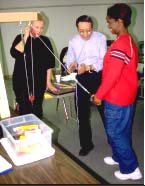
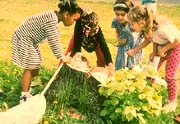
( BACK TO POSTER | BACK TO TOP )
It is unrealistic to expect to train all of the teachers in a large urban system like Buffalo in five years. In fact, given the teacher attrition rate we have experienced in recent years, it is unlikely that we will ever reach the point where all Buffalo teachers are fully trained in three TEAM kits. The target population is continuously turning over, and this does not include the number of teachers that change grade levels each year and therefore require additional kit training. Under these circumstances the most realistic approach to implementing an LSC is to invest in a large cadre of career classroom teachers that can carry on continuous training following the termination of the grant period. As Buffalo does not have the money to support TOSAs, we have found that he most effective strategy has been to use working classroom teachers as workshop leaders, mentor teachers, and facilitators. This has proved to be a cost-effective approach because the district can provide workshop leaders at minimal expense. Also, experienced classroom teachers, who are currently teaching the program in their classrooms, have a very high level of credibility with teachers. The challenge, of course, is to teach classroom teachers, who have little experience teaching adults, how to work effectively with their peers. In a district that is highly authoritarian with a tradition of top-down management, developing a culture of professionalism among teachers, where teachers are mentors to their colleagues, is a major challenge, but cultivating such a culture in a museum setting has been a crucial ingredient of our success. Continuing the partnership between the school district and the Museum can play a strong role in maintaining this culture of colleagueship and professionalism.
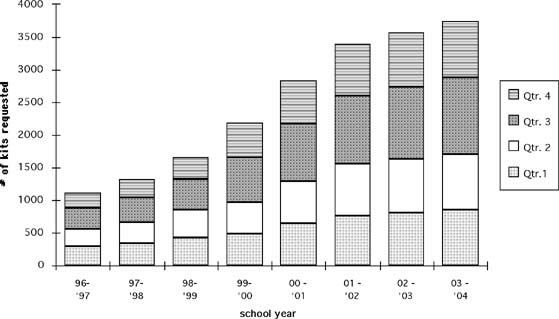
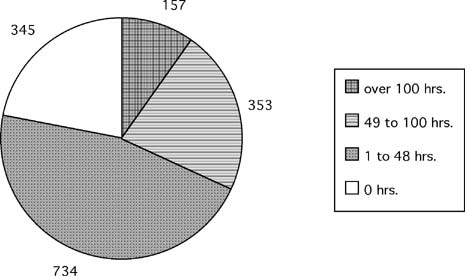
( BACK TO POSTER | BACK TO TOP )
New projects should attempt to verify the long-term commitment of the participating school districts. This is difficult to arrange because school districts typically can't predict funding availability beyond one year. Lacking long term commitment experimental, externally funded programs seldom survive beyond the duration of the grant period. With TEAM 2000 we successfully negotiated a generous (c. $400,000 per year) continuing investment in staff and materials support, and this district commitment was crucial in receiving funding from NSF. Once the program proved successful, and received enthusiastic recommendations from teachers and administrators, this annual investment became an accepted component of the districts operating budget. None of this would have been possible without the backing of the Assistant Superintendent for Curriculum, who was a co-PI and strong supporter of TEAM from the outset. We would strongly recommend securing such district by-in before launching an LSC.
( BACK TO POSTER | BACK TO TOP )
The TEAM project has not been very successful at promoting itself with middle level managers and the general public. Although we have reached hundreds of teachers, have build a support system that teachers say is unprecedented in their experience with the school district (kits arrive on time and are properly refurbished, training is well done, and people are paid promptly) we still remain fairly low down on the priority list of many district principals and administrators. Reading and math are the central priorities with principals because they are what are tested. We need better to articulate how quality science teaching can improve reading and math scores. We are well liked by the School Board and the Superintendent but could use greater general visibility. We would love to know how other projects have successfully marketed themselves.
We also would like to know how other districts have succeeded in getting university course credit for their workshop offerings. We now have a sophisticated series of courses, based on a modification of the Pasadena modules, that we are offering at the advanced professional development level. These courses are designed in one credit (15 hour) increments and would be very suitable for both pre-service and in-service course credit, but so far we have been unsuccessful in negotiating the labyrinth of university politics to get this accomplished. We would greatly appreciate any help we can get from other projects in solving this problem.
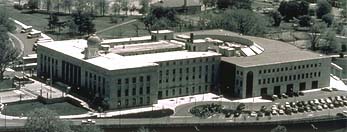
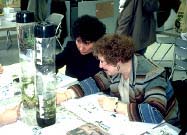
THIS POSTER WAS PREPARED BY
Peter Dow and David Hartney of the TEAM 2000 project.
( BACK TO POSTER | BACK TO TOP )
|